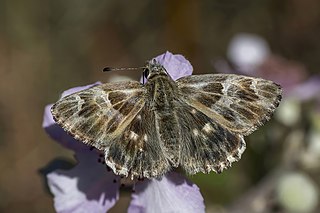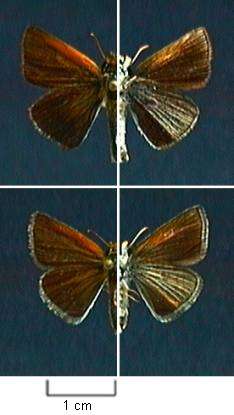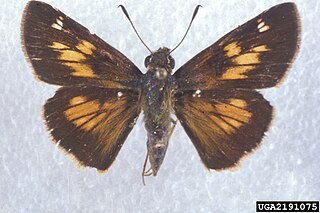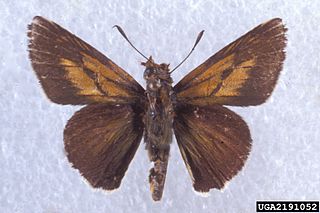
Papilio glaucus, the eastern tiger swallowtail, is a species of butterfly native to eastern North America. It is one of the most familiar butterflies in the eastern United States, ranging north to southern Ontario, Canada, and is common in many different habitats. It flies from spring until fall, during which it produces two to three broods. Adults feed on the nectar of many species of flowers, mostly from those of the families Apocynaceae, Asteraceae, and Fabaceae. P. glaucus has a wingspan measuring 7.9 to 14 cm. The male is yellow with four black "tiger stripes" on each forewing. Females may be either yellow or black, making them dimorphic. The yellow morph is similar to the male, but with a conspicuous band of blue spots along the hindwing, while the dark morph is almost completely black.

The large skipper is a butterfly of the family Hesperiidae.

Grass skippers or banded skippers are butterflies of the subfamily Hesperiinae, part of the skipper family, Hesperiidae. The subfamily was established by Pierre André Latreille in 1809.

Gegenes nostrodamus, commonly known as the dingy swift, light pygmy skipper, Mediterranean skipper or veloz de las rieras, is a butterfly belonging to the family Hesperiidae. It is found from the Mediterranean Sea, through Anatolia to Turkestan and India.

Ancyloxypha numitor, the least skipper, is a North American butterfly in the family Hesperiidae. They have a weak, Satyrinae-like flight.

Polites themistocles, the tawny-edged skipper, is a North American butterfly in the family Hesperiidae.

The Euphyes is genus of North American butterfly of the family Hesperiidae (skippers), subfamily Hesperiinae.

Favria is a monotypic genus of spread-wing skippers in the butterfly family Hesperiidae. This genus was formerly a synonym of Muschampia, and its only species, Favria cribrellum, was formerly a member of Muschampia. The species is commonly known as the spinose skipper.

Muschampia orientalis, the Oriental skipper, or Oriental marbled skipper, is a butterfly of the family Hesperiidae. It is found in Montenegro, Albania, North Macedonia, Romania, Bulgaria and Greece, east to Asia Minor, northern Iran, Ukraine, the Caucasus to Kazakhstan and Turkmenistan. There is a disjoint population in northern Hungary. In the south it is also found in Wadi Al Hisha (Jordan) and Israel.

The crystal skipper is a species of butterfly in the family Hesperiidae that is found only along a 30-mile (50 km) stretch of barrier islands in North Carolina. The skipper was first discovered in 1978 and the paper describing it as a full species was published in 2015.

Amblyscirtes carolina, the Carolina roadside skipper, is a species of butterfly in the family Hesperiidae. It is found from south-eastern Virginia, south to South Carolina, west to northern Mississippi. There are disjunct populations in Delaware, southern Illinois and northwest Arkansas.

Atrytonopsis loammi, the Loammi skipper or southern dusted skipper, is a butterfly of the family Hesperiidae. It is found in the United States on barrier islands in North Carolina and from South Carolina to Florida and Mississippi.

Euphyes vestris, the dun skipper, sedge witch or dun sedge skipper, is a species of butterfly of the family Hesperiidae. It is found in North America from Nova Scotia west across southern Canada to southern Alberta, south to Florida, the Gulf Coast and eastern Texas. There are disjunct populations in the High Plains and Rocky Mountains and along the Pacific Coast.

Oarisma poweshiek, the Poweshiek skipperling, is a North American butterfly in the family Hesperiidae (skippers), subfamily Hesperiinae. The range of this species in Canada is restricted to southeastern Manitoba, and in the United States it historically ranged from the Dakotas to the southern Lower Peninsula of Michigan.

Oarisma garita, the Garita skipperling, western skipperling or Garita skipper, is a North American butterfly in the family Hesperiidae (skippers), subfamily Hesperiinae . This skipper ranges southeastern Manitoba to British Columbia and south through the American Midwest as far south as Mexico. Its habitats include dry or moist prairies, open woodlands, and limestone outcrops.

Poanes yehl, the Yehl skipper, is a butterfly of the family Hesperiidae. It is found from southeastern Virginia west to southwestern Missouri and south to eastern Texas, the Gulf Coast and northern Florida.

Euphyes dukesi, or Dukes' skipper, is a butterfly of the family Hesperiidae. It lives in the eastern United States and in a small portion of southern Ontario, Canada, in three distinct populations. Preferred habitats are shaded wetlands, with various species of sedge plants it uses as host plants for its larvae.

Euphyes arpa, the palmetto skipper, is a butterfly of the family Hesperiidae.

Oligoria maculata, the twin-spot skipper, is a species of butterfly in the family Hesperiidae. It is found in the United States along the coast of North Carolina south through Florida and west along the Gulf Coast to east Texas. Strays can be found as far north as Pennsylvania, Maryland and New Jersey.

Euphyes bimacula, the two-spotted skipper, is a butterfly of the family Hesperiidae. It is found in North America, from northeast Colorado and western Nebraska; eastern Nebraska east to southern Quebec; southern Maine south to central Virginia; coastal plain south to Georgia; and the Gulf Coast.





















